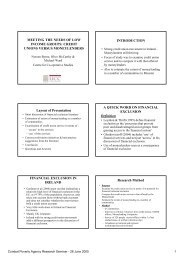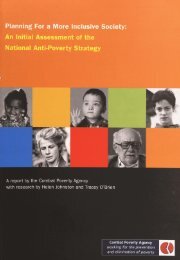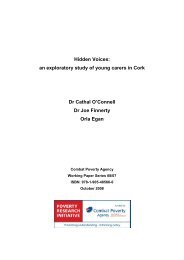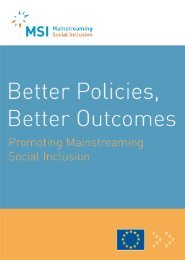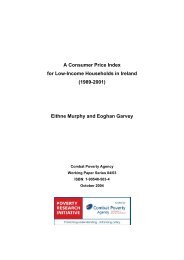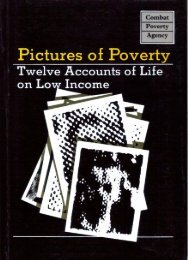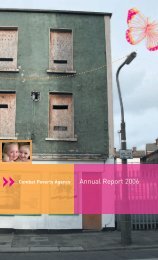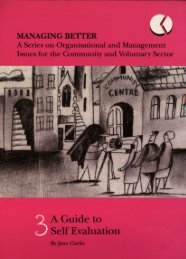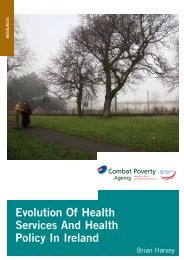The Distribution of Income in Ireland (2000) - Combat Poverty Agency
The Distribution of Income in Ireland (2000) - Combat Poverty Agency
The Distribution of Income in Ireland (2000) - Combat Poverty Agency
- No tags were found...
Create successful ePaper yourself
Turn your PDF publications into a flip-book with our unique Google optimized e-Paper software.
80<strong>The</strong> <strong>Distribution</strong> <strong>of</strong> <strong>Income</strong> <strong>in</strong> <strong>Ireland</strong>7.2 WOMEN'S LABOUR FORCE PARTICIPATION IN IRELANDTo see the Irish situation <strong>in</strong> comparative context, Table 7.1shows female participation rates for various OECD countries <strong>in</strong>both 1984 and 1994. In 1984 the female labour force participationrate <strong>in</strong> <strong>Ireland</strong> was 37 per cent. In contrast, many <strong>of</strong> theother countries had female participation rates <strong>of</strong> over 50 percent. For <strong>in</strong>stance, the participation rate <strong>in</strong> the US was approximately63 per cent, 59 per cent <strong>in</strong> the U.K, 53 per cent <strong>in</strong> Germanyand 77 per cent <strong>in</strong> Sweden. Of the OECD countries <strong>in</strong> thetable, only Spa<strong>in</strong> had a lower participation rate than <strong>Ireland</strong>. By1994 the participation rate <strong>in</strong> <strong>Ireland</strong> had <strong>in</strong>creased to 47 percent. Table 7.1 shows that <strong>of</strong> the OECD countries for which dataare available only four — Luxembourg, Netherlands, New Zealandand Spa<strong>in</strong> — experienced greater percentage <strong>in</strong>creases <strong>in</strong>the female participation rate than <strong>Ireland</strong>. <strong>The</strong>se <strong>in</strong>creases <strong>in</strong>participation and employment have cont<strong>in</strong>ued s<strong>in</strong>ce 1994. Indeed,the employment <strong>in</strong>creases among Irish women between1991 and 1997 exceeded the comb<strong>in</strong>ed employment <strong>in</strong>creasesover the previous 20 years. Many have argued that this hascontributed substantially to <strong>Ireland</strong>'s impressive growth recordsmce the early 1990's (see for example Bradley, FitzGerald,Honohan and Kearney 1997).To understand the effect <strong>of</strong> <strong>in</strong>creas<strong>in</strong>g female participationon household <strong>in</strong>come <strong>in</strong>equality, one needs <strong>in</strong>formation show<strong>in</strong>gwhere <strong>in</strong> the <strong>in</strong>come distribution these changes have beensccumng, and also what has been happen<strong>in</strong>g to female wagesas women's participation and employment <strong>in</strong>creased. For this?S?° Se iro e , USe *• *° house «°ld surveys carried out by theESRI m 1987 and 1994, described <strong>in</strong> detail <strong>in</strong> earlier chapters.at this po<strong>in</strong>t isfocus ^*• household. However, tohn,,.^0^r ° le ° f female Participation we concentrate onhouseholds conta<strong>in</strong><strong>in</strong>g a married couple <strong>in</strong> which both spousesb0th mus J£Ti?"a 9 ed betwe *n 24 and 55. This leavesus with 1,546 households <strong>in</strong> 1987, and 1,855 households <strong>in</strong> 1994.Female Labour Force Participation and Inequality 81Table 7.1: Female Participationand 1994AustraliaAustriaBelgiumCanadaDenmarkF<strong>in</strong>landFranceGermanyGreeceIceland<strong>Ireland</strong>ItalyJapanKoreaCountryLuxembourgNetherlandsNew ZealandNorwayPortugalSpa<strong>in</strong>SwedenSwitzerlandUKUSRates <strong>in</strong> the OECD, J984Female Participation Rate (%)198452.851.548.763.573.872.954.752.340.962.736.940.757.243.842.240.746.066.356.033.277.355.759.162.8199463.462.155.167.873.869.959.661.844.680.047.242.962.152.756.557.465.071.162.044.174.467.566.270.5Change <strong>in</strong>ParticipationRate (% po<strong>in</strong>ts)II ls useful now todist<strong>in</strong>guishocus<strong>in</strong>g on these households, between the two surveys therea significant <strong>in</strong>crease <strong>in</strong> the percentage <strong>of</strong> married women^ork<strong>in</strong>g as employees. In 1987 approximately 22 per cent <strong>of</strong>^ves were classified as employees, but by 1994 this had <strong>in</strong>fouT8601 tQ 34 Per C6nt " betweensources <strong>of</strong> household <strong>in</strong>come: husband's employee earn-+20+20+ 13+70-5+8+ 18+9+28+28+6+9+20+34+41+41+7+11+33-4+21+ 12+ 12




